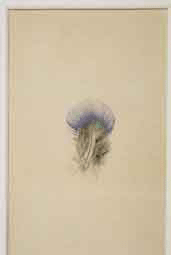Study of a Peacock's Breast Feather
John Ruskin (1819–1900). Watercolour on paper, 1873
WorkIn their edition of Love's Meinie (1873), Cook and Wedderburn include 'examples of Ruskin's studies of birds'. They explain that one plate was 'made from Ruskin's studies of peacock's feathers', and indicate that these watercolour 'drawings' are 'in the Ruskin Museum at Sheffield' (Works, 25, p. liii). This is a good example of the kind of 'instruction by example' that Ruskin hoped would underpin the work of the Museum.Ruskin was particularly fond of the peacock's feather as a subject, and liked to present such work as a priority. In Fors Clavigera, he breaks off a letter with the explanation that 'I must stop writing because I've to draw a peacock's breast-feather, and paint as much of it as I can without having heaven to dip my brush in.' (December 1875, Works, 28, p. 466).
Ruskin on Drawing FeathersIn The Laws of Fésole (1877-8), Ruskin gives a lesson to his readers in drawing feathers, and takes one plume 'from the back of the peacock, for a first study of plume-radiation' (Works, 15, p. 409). Later in the same work, he makes a detailed examination of the bird's plumage:'If you examine a fine tail-feather of the peacock, above the eye of it, you will find a transparent space formed by the cessation of the barbs along a certain portion of the shaft. On the most scintillant of the rays, which have green and golden barbs, and in the lovely blue rays of the breast-plumes, these cessations of the barbs become alternate cuts or jags; while at the end of the long brown wing-feathers, they comply with the coloured pattern: so that, at the end of the clouded plume, its pattern, instead of being constructed of brown and white barbs, is constructed of brown -- and no barbs, -- but vacant spaces. The decorative use of this transparency consists in letting the colour of one plume through that of the other, so that not only every possible artifice is employed to obtain the most lovely play of colour on the plume itself; but, with mystery through mystery, the one glows and flushes through the other, like cloud seen through cloud.' (Works, 15, p. 413) Ruskin on PeacocksIn The Stones of Venice (1851; 1853), Ruskin explained that the peacock is 'the well-known symbol of the resurrection', on account of the annual change and renewal of its dramatically coloured feathers (Works, 10, p. 171).Ruskin also associated peacocks with Byzantine decoration, in particular the peacock mosaics in St Mark's Basilica. Collection of the Guild of St George, Museums Sheffield
In St Mark's Rest (1877-84), he lamented the destructive 'restoration' of these mosaics:'Their mosaics especially were of such exquisite intricacy of deep golden glow between the courses
of small pillars, that those two upper arches had an effect as of peacock's feathers in the sun, when their green and purple glitters through and through with light. But now they have the look of a peacock's feather that has been dipped in white paint. I cannot guess where the sandy or muddy brown stone has been brought from (the commonest kinds of Verona marble being brighter), nor can I understand how Venetian people can bear to look at such colour' (Works, 24, p. 408).In the Eagle's Nest (1872), the peacock's feather becomes a flashpoint in the debate between Ruskin and Darwinism:'by the time you have copied one or two of your exercises on the feather of the halcyon, you will be more interested in the construction and disposition of plumefilaments than heretofore; and you may, perhaps, refer, in hope of help, to Mr. Darwin's account of the peacock's feather. I went to it myself, hoping to learn some of the existing laws of life which regulate the local disposition of the colour. But none of these appear to be known; and I am informed only that peacocks have grown to be peacocks out of brown pheasants, because the young feminine nine brown pheasants like fine feathers. Whereupon I say to myself, "Then either there was a distinct species of brown pheasants originally born with a taste for fine feathers; and therefore with remarkable eyes in their heads, -- which would be a much more wonderful distinction of species than being born with remarkable eyes in their tails, -- or else all pheasants would have been peacocks by this time!" And I trouble myself no more about the Darwinian theory. When you have drawn some of the actual patterns of plume and scale with attention, I believe you will see reason to think that spectra of organic species may be at least as distinct as those of metals or gases; but learn at all events what they are now, and never mind what they have been.' (Works, 22, pp. 247-8) |



















